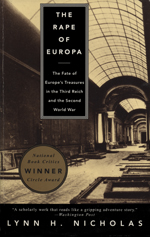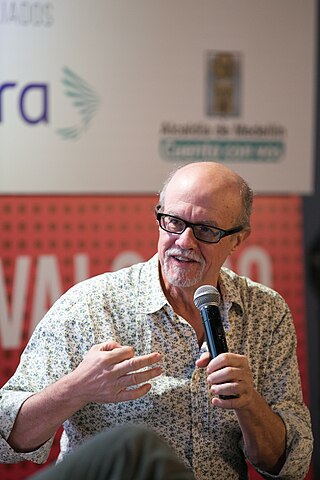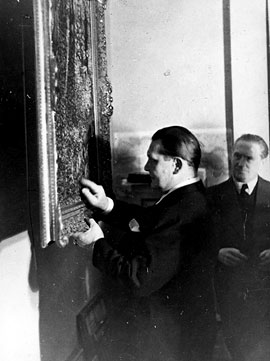Related Research Articles

Looting is the act of stealing, or the taking of goods by force, typically in the midst of a military, political, or other social crisis, such as war, natural disasters, or rioting. The proceeds of all these activities can be described as booty, loot, plunder, spoils, or pillage.
Much of the focus of the discussion about Nazi gold concerns how much of it Nazi Germany transferred to overseas banks during World War II. The Nazis looted the assets of their victims to accumulate wealth. In 1998, a Swiss commission estimated that the Swiss National Bank held $440 million of Nazi gold, over half of which is believed to have been looted.

Nazi plunder was organized stealing of art and other items which occurred as a result of the organized looting of European countries during the time of the Nazi Party in Germany.

Looted art has been a consequence of looting during war, natural disaster and riot for centuries. Looting of art, archaeology and other cultural property may be an opportunistic criminal act or may be a more organized case of unlawful or unethical pillage by the victor of a conflict. The term "looted art" reflects bias, and whether particular art has been taken legally or illegally is often the subject of conflicting laws and subjective interpretations of governments and people; use of the term "looted art" in reference to a particular art object implies that the art was taken illegally.

The Monuments, Fine Arts, and Archives Section Unit (MFAA) was a program established by the Allies in 1943 to help protect cultural property in war areas during and after World War II. The group of about 400 service members and civilians worked with military forces to protect historic and cultural monuments from war damage, and as the conflict came to a close, to find and return works of art and other items of cultural importance that had been stolen by the Nazis or hidden for safekeeping. Spurred by the Roberts Commission, MFAA branches were established within the Civil Affairs and Military Government Sections of Allied armies.

The Rape of Europa: The Fate of Europe's Treasures in the Third Reich and the Second World War is a 1994 book by Lynn H. Nicholas and a 2006 documentary film. The book explores the Nazi plunder of looted art treasures from occupied countries and the consequences. It covers a range of associated activities: Nazi appropriation and storage, patriotic concealment and smuggling during World War II, discoveries by the Allies, and the extraordinary tasks of preserving, tracking, and returning by the American Monuments officers and their colleagues. Nicholas was awarded the Légion d'Honneur by France.

Wilhelm Peter Bruno Lohse was a German art dealer and SS-Hauptsturmführer who, during World War II, became the chief art looter in Paris for Hermann Göring, helping the Nazi leader amass a vast collection of plundered artworks. During the war, Göring boasted that he owned the largest private art collection in Europe.

Hector Feliciano is a Puerto Rican journalist and author whose book "The Lost Museum: The Nazi Conspiracy to Steal the World's Greatest Works of Art" has shed light on an estimated 20,000 works of art plundered by the Nazis; each one is owned by a museum or a collector somewhere.

The Reichsleiter Rosenberg Taskforce was a Nazi Party organization dedicated to appropriating cultural property during the Second World War. It was led by the chief ideologue of the Nazi Party, Alfred Rosenberg, from within the NSDAP Office of Foreign Affairs. Between 1940 and 1945, the ERR operated in France, Netherlands, Belgium, Poland, Lithuania, Latvia, Estonia, Greece, Italy, and on the territory of the Soviet Union in the Reichskommissariat Ostland and Reichskommissariat Ukraine. Much of the looted material was recovered by the Allies after the war, and returned to rightful owners, but there remains a substantial part that has been lost or remains with the Allied powers.

Franz Neuhausen was a wealthy industrialist who became the special plenipotentiary for economic affairs in the Territory of the Military Commander in Serbia during most of the German military occupation of that region of the partitioned Kingdom of Yugoslavia during World War II. He worked as a representative of Germany and the Nazi Party in Belgrade throughout the 1930s, during which he amassed a huge fortune. As a close friend and personal favourite of Reichsmarshall Hermann Göring, he became Göring's direct representative for the Four Year Plan in the occupied territory, and was its virtual economic dictator from April 1941 until August 1944. On 18 October 1943 he succeeded Harald Turner as the Chief of the Military Administration in Serbia, and he continued to fulfill both roles until late August 1944.

The looting of Polish cultural artifacts and industrial infrastructure during World War II was carried out by Nazi Germany and the Soviet Union simultaneously after the invasion of Poland of 1939. A significant portion of Poland's cultural heritage, estimated at about half a million art objects, was plundered by the occupying powers. Catalogued pieces are still occasionally recovered elsewhere in the world and returned to Poland.
The Offenbach Archival Depot was a central collecting point in the American Sector of Germany for books, manuscripts and archival materials looted, confiscated or taken by the German army or Nazi government from the occupied countries during World War II. From the Offenbach Archival Depot, these materials of looted art and Nazi plunder were sorted and eventually returned to their original country of origin, or otherwise maintained in new collections.

Alois Miedl was a naturalized Dutch art dealer, originally a German Nazi banker, born in Munich, who had moved to and was mainly active in the Netherlands, involved with the sales of properties stolen from Jews who had fled or had been deported.

Walter Andreas Hofer was a German art dealer who was Hermann Göring's principal art agent, director of the Göring Collection, and an important figure in Nazi art looting during World War II. Hofer is referenced 162 times in the OSS Art Looting Investigation Units Reports of 1945-1946. He was not a member of the Nazi Party. After the war he continued to work as an art dealer in Munich.

Theodor Fischer (1878–1957) was a Swiss art dealer and auctioneer in Lucerne who after the First World War built a highly successful firm of auctioneers that dominated the Swiss art market. In 1939 he was the auctioneer at the infamous Grand Hotel auction of "degenerate art" removed from German museums by the Nazis. During the Second World War he played a key part in the trading of art looted by the Germans from occupied countries.

Karl Haberstock was a Berlin art dealer who trafficked in Nazi-looted art. Haberstock's name appears 60 times in the Art Looting Investigation Unit (ALIU) Reports 1945–1946 and ALIU Red Flag Names List and Index.
The German Nazi Party looted and stole art, gold and other objects that had been either plundered or moved for safekeeping at various storage sites during World War II. These sites included salt mines at Altaussee and Merkers and a copper mine at Siegen.
Kurt Freiherr von Behr headed the Nazi art looting organisation, Einsatzstab Reichsleiter Rosenberg (ERR), in Paris and was involved in the M-Action which looted the home furnishings of French Jews.
The Hermann Göring Collection, also known as the Kunstsammlung Hermann Göring, was an extensive private art collection of Nazi Reichsmarschall Hermann Göring, formed for the most part by looting of Jewish property in Nazi-occupied areas between 1936 and 1945.

Walter Bornheim was a German art dealer deeply involved in Nazi looted art.
References
- ↑ Author(s). Schiffer Books. Retrieved 2 February 2015.